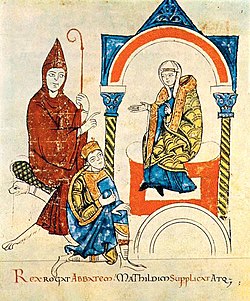1100-1200 in fashion
Costume during the twelfth century in Europe was simple and differed only in details from the clothing of the preceding centuries. Men wore knee-length tunics for most activities, and men of the upper classes wore long tunics, with hose and mantles or cloaks. Women wore long tunics or gowns. A close fit to the body, full skirts, and long flaring sleeves were characteristic of upper class fashion for both men and women.
Men's clothing
Shirt, braies, and chausses
Underclothes consisted of an inner tunic (French chainse) or shirt with long, tight sleeves, and drawers or braies, usually of linen. Tailored cloth leggings called chausses or hose, made as separate garments for each leg, were often worn with the tunic; striped hose were popular.
During this period, beginning with the middle and upper classes, hose became longer and more fitting, and they reached above the knees. Previously, they were looser and worn with drawers that ranged from knee- to ankle-length. The new type of hose was worn with drawers that reached the knees or above, and they were wide enough at the top to allow the drawers to be tucked into them. They were held up in place by being attached to the girdle of the drawers.
The better fit and girdle attachment of this new hose eliminated the need for the leg bands often worn with earlier hose. In England, however, leg bands continued to be worn by some people, both rich and poor, right up to the reign of Richard I. After 1200, they were largely abandoned.
Outer tunics and doublets
Over the undertunic and hose, men wore an outer tunic that reached to the knees or ankles, and that was fastened at the waist with a belt. Fitted bliauts, of wool or, increasingly, silk, had sleeves that were cut wide at the wrist and gored skirts. Men wore bliauts open to the waist front and back or at the side seams.
Newly fashionable were short, fitted garments for the upper body, worn under the tunic: the doublet, made of two layers of linen, and an early form of quilted and padded jupe or gipon.
The sleeveless surcoat or cyclas was introduced during this period as protective covering for armour (especially against the sun) during the Crusades. By the nest century, it would become widely adopted as civilian dress.
Rectangular and circular cloaks were worn over the tunic. These fastened on the right shoulder or at the center front.
Headgear
Men of the upper classes often went hatless. The chaperon in the form of hood and attached shoulder-length cape was worn during this period, especially by the rural lower classes, and the fitted linen coif tied under the chin appeared very late in the century. Small round or slightly conical caps with rolled brims were worn, and straw hats were worn for outdoor work in summer.
Women's clothing

Chemise and tunic
Women's clothing consisted of an undertunic called a chemise, chainse or smock, usually of linen, over which was worn one or more ankle-to-floor length tunics (also called gowns or kirtles).
Working class women wore their tunics ankle-length and belted at the waist.
Women of the French court wore a loosely fitted tunic called a cotte or the form-fitting bliaut over a full chemise with tight sleeves. The bliaut had a flaring skirt and sleeves tight to the elbow and then widening to wrist in a trumpet shape. A bliaut apparently cut in one piece from neckline to hem depicted on a column figure of a woman at the Cathedral of St. Maurice at Angers has visible side-lacing and is belted at the natural waistline.A new fashion, the bliaut gironé, arose in mid-century: this gown is cut in two pieces, a fitted upper portion with a finely pleated skirt attached to a low waistband.
The fitted bliaut was sometimes worn with a long belt or cincture (in French, ceinture) that looped around a slightly raised waist and was knotted over the abdomen; the cincture could have decorative tassels or metal tags at the ends.
In England, the fashionable gown was wide at the wrist but without the trumpet-shaped flare from the elbow seen in France.
Hairstyles and headdresses
Married women, in keeping with Christian custom, wore veils over their hair, which was often parted in the center and hung down in long braids that might be extended with false hair or purchased hair from the dead, a habit decried by moralists.
The wimple was introduced in England late in the century. It consisted of a linen cloth that covered the throat (and often the chin as well), and that was fastened about the head, under the veil.











No comments:
Post a Comment